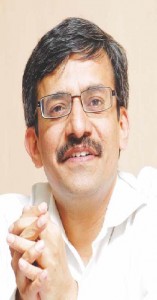 Vineet Joshi, Chairman, Central Board of Secondary Education (CBSE) in conversation with Dr Ravi Gupta, Sheena Joseph and Yukti Pahwa, talks about the vision and role of CBSE as an institution. He shares with the team his outlook on ICT inclusion in schools and implementation of Continuous and Comprehensive Evaluation
Vineet Joshi, Chairman, Central Board of Secondary Education (CBSE) in conversation with Dr Ravi Gupta, Sheena Joseph and Yukti Pahwa, talks about the vision and role of CBSE as an institution. He shares with the team his outlook on ICT inclusion in schools and implementation of Continuous and Comprehensive Evaluation
The objective of school programmes should be to help children realise that there is science everywhere
Regulating K12 Education Centrally :
What is the main role of CBSE?
CBSE is not an administrative body, which grooms the schools. Our role is to issue guidelines that inform the clientele (schools affiliated to CBSE) about the good
practices available in the field. The idea of circulating the circulars to the schools is to make them aware of the possibilities that exist. In the times to come, if schools desire, we will come up with guidelines on how to process the available mechanisms optimally. The focus of CBSE over years has shifted from being just an examination body to an academic body.
What is CBSE’s vision with respect to implementation of ICT at schools?
Firstly, there is an issue of the numbers. If we need to reach out to a large numberof schools, it is imperative to use ICT. Secondly, ICT can help a teacher
go beyond monotony and better time management. Additionally, what National
Council for Educational Research and Training (NCERT) has prescribed,in terms of ICT, should be integrated in classrooms. We encourage self-realisation amongst schools.
Can you elaborate on Continuous and Comprehensive Evaluation (CCE) and the role that ICT holds for implementation of CCE?
Teacher is the nodal point of implementing CCE. At the same time CCE is meant for the students. We are working towards realising benefits for both. For teachers, we are working on the supply side of knowledge. We are coming up with content on formative assessments. Summative assessments take place only at the end of the term, while the CCE is continuous in nature, done at regular intervals of time, with purpose of diagnosing problem areas and suggesting remedial actions for the same. This is the basis of CCE. We are also going to start with training on the formative assessments, in the coming year. On the demand side, we are sensitising the parents, as to what they should be expecting inside the classroom. We are working for both the sides – equipping teachers and principals on one hand, and parents on another; so that everybody can appreciate the system and demand it. As far as ICT goes, its integration with CCE is important. One of the immediate uses of ICT is the help it provides in processing of records and records-keeping for the teachers. It also facilitates good learning environment inside the classroom.
With a country where the usual ratio in a class is one teacher to 50-60 students, do you think CCE implementation is viable?
Firstly, under the right to education act every school till standard eight is suppose to have teacher to student ratio of 1:30. Its actual implementation in classrooms might take time, but, the ratio has to come into place across all the schools as it is one of the mandates prescribed under the act. Secondly, the schools will have to come out with innovative ideas on addressing the issue of large number of students, in respective classrooms. ICT usage is supportive of CCE implementation. It is not meant to be a burden for teachers but otherwise.
CCE entails evaluation and explanation of the evaluation done. It is very important for teachers to explain the reason why a child scores an eight on ten or a nine on ten, and why certain marks were lost.
 One of the immediate uses of ICT is the help it provides in recordskeeping for the teachers. It also facilitates good learning environment inside the classroom
One of the immediate uses of ICT is the help it provides in recordskeeping for the teachers. It also facilitates good learning environment inside the classroom
How does CBSE work for maintaining
evaluation standards?
Formative assessment done earlier didn’t carry any weightage or make a difference to students’ final grades. It was only meant for feedback.Secondly, summative assessments were done by the schools. The board’s intervention ensures that a minimum standard, which is to be maintained by students who pass out of this system, is to beachieved; and it ensures that the teachers prepare and teach the required syllabus to the students without escaping or missing any topic. The idea is to encourage teachers to develop skills for carrying out such assessments independently. Formative system will take some time but for summative assessments, board is already giving its support to the schools by preparing papers or considering the papers that schools prepare and send to us for approval. This ensures that existing standards are atleast maintained.
Is ICT application encouraged internally at CBSE?
We have integrated ICT as much as we could within our own system. For instance, the process of acquiring affiliation with us has been made possible online. Right from the first step of getting applications to the final submission,
everything is to be done digitally. Our officers are equipped to use computers.
Earlier, we would get 500-600 application requests for affiliation but now because of making the process digitally equipped, the number of application requests reached a high number of 3000 in the year 2010. Earlier processing of the same would take a year but now it takes only six months, while maintaining transparency. We mostly use online mode for communicating to the applicants and this has also helped in minimising various errors.
How is CBSE catering to its students if compared with the global situation?
In India we might not be the largest board, but if you compare CBSE with any international board, we cater to quite significant number of student population. Total number of schools we cater to is 11,441 (till November 2010). In terms of number of students, across Xth and XIIth class, we cater to nine lakh and seven lakh respectively, multiplied by five to give a rough estimate.






















